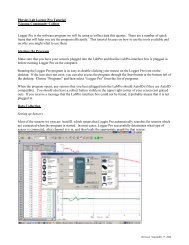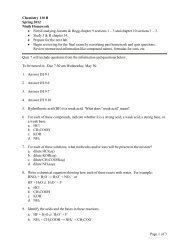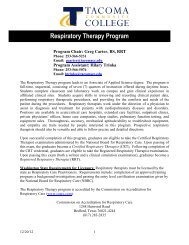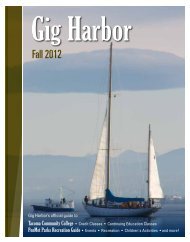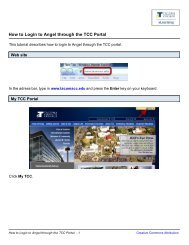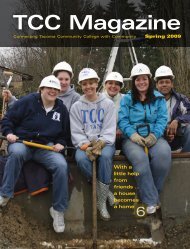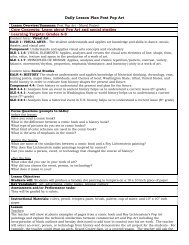2005-07 Catalog - Tacoma Community College
2005-07 Catalog - Tacoma Community College
2005-07 Catalog - Tacoma Community College
- No tags were found...
You also want an ePaper? Increase the reach of your titles
YUMPU automatically turns print PDFs into web optimized ePapers that Google loves.
<strong>2005</strong>-20<strong>07</strong> <strong>Catalog</strong>Credit Course Descriptions 101Emergency Medical and Health ServicesELEC 212Wireless Theory (5)A study of wireless frequency usage toinclude cellular and fixed broadband,transmission methodologies, equipmentusage, transmitter range, FCC licensing,tower and antenna usage and fundamentals.ELEC 214Network Security Fundamentals (5)A study of radio frequency vulnerabilitiesas they pertain to applied transmissionmethods. An introduction to hardware andsoftware firewall and encryption techniquesused in the cellular and fixed broadbandtechnologies.ELEC 216Principles of Wireless Networks (5)An introduction to the incorporation ofwireless technologies and equipment in thedevelopment and application of wirelessbroadband and cellular networks.ELEC 218Radio Wave Modulationand Signal Propagation (5)A study of the various methods used formodulating and demodulating radiofrequency transmission, signal propagation asit pertains to frequency, transmitter power,topography, and atmospheric effect.ELEC 220Advanced Network Security and Encryption (5)Application of security and encryptionmethods in a wireless environment. Variousmethods demonstrated, vulnerabilitiesisolated and opportunities presented tosecure systems.ELEC 221Cellular Networking (5)A continuation of ELEC 216. Incorporatesand introduces cell site and cellulartechnologies to include: components,protocol layers, data services, and standardsto include FCC licensing.Prerequisite: ELEC 216, 218 and MATH 115with a grade of ‘C’ or higher.ELEC 290Work Internship (5)Upon completing the requirements for theE/WTE certificate, students may receivecollege credit for hands-on electronic relatedwork experience and training in a private orpublic sector organization.Prerequisite: Program chair permission.Emergency Medical and HealthServicesEMC 110 (F, W, Sp)Emergency Medical Technician Basic (8)Upon completion of this course, studentsare prepared to fulfill state and/or NationalRegistry requirements for certification as anEMT-Basic, the entry level position in EMSfor pre-hospital care providers.EMT-Bs provide basic life support andtransportation for victims of illness and injury.Includes 112 hours of lecture and practicalclass-work time, and some clinical observation.Class also meets a portion of the prerequisitesfor the Paramedic program. Program adheresto the U.S. Department of Transportationguidelines and the Washington StateDepartment of Social and Health Servicesstandards.Prerequisites: At least 18 years old, high schoolgraduation or GED, CPR card, Standard FirstAid Training and valid driver's license. Applicationand screening are necessary prior to course, due tolimited enrollment and prerequisites.NOTE: Active affiliation with an EMS provideragency is required for state certification. Class maybe taken without affiliation; however, students willnot obtain state certification without being affiliated.EMC 112 (F, W, Sp)Emergency Medical TechnicianRecertification (4)For the currently certified EMT-Basic whoneeds to fulfill state and/or National Registryrequirements for recertification.Prerequisite: Current state or National RegistryEMT-Basic. Certification and Program Chairpermission.EMC 115Pre-Hospital Trauma Life Support (PHTLS) (2)Pre-Hospital Trauma Life Support (PHTLS)is a nationally recognized course that focuseson improving the care rendered to thevictims of trauma in the out-of-hospitalsetting. The course features a blend offocused classroom presentations coupledwith extensive hands-on experiences to helpturn the theories and concepts of qualitytrauma care into practical application.EMC 118 (F)EMS Wellness and Prevention (4)This course will explore the various factorsthat impact the physical and mental wellbeing of the paramedic. A wide range ofhealth and prevention concepts will bepresented to enhance personal wellness. Thestudents will also learn the function ofparamedics as role models, coaches, andeducators in the community.EMC 120 (F)Paramedic I (12)First of three didactic/lab courses of theParamedic education program. Coversadvanced concepts and skills in patientAssessment, airway management, shockmanagement and I. V. therapy, pharmacologyand drug administration, Advanced CardiacLife Support (ACLS) provider course included.Prerequisite: HT 130, BIOL 118, EMC 118and acceptance into the Paramedic program.EMC 121 (W)Paramedic II (12)Second didactic/lab class in the three-quarterparamedic course. Covers Assessment andmanagement of the trauma victim; soft tissueinjuries; respiratory emergencies;musculoskeletal injuries; medical, pediatric,psychiatric, obstetric and geriatricemergencies. Pre-hospital trauma life support(PHTLS-Provider) as well as the P.E.P.P.provider course included.Prerequisites: Successful completion of EMC 120,EMC 130 and PE 100.EMC 122 (Sp)Paramedic III (5)Third didactic/lab class in the three-quartercourse. Reviews the entire didactic contentutilizing case studies. Requires application ofthe material covered in EMC 120 and EMC121.Prerequisites: Successful completion of EMC 121,EMC 131 and PE 200.EMC 130 (F)Paramedic Clinical I (4)First-quarter clinical and infield experiencefor paramedic students taken in conjunctionwith EMC 120; includes supervised clinicalexperience in hospital and infield rotations.Prerequisite: Enrollment in EMC 120.




